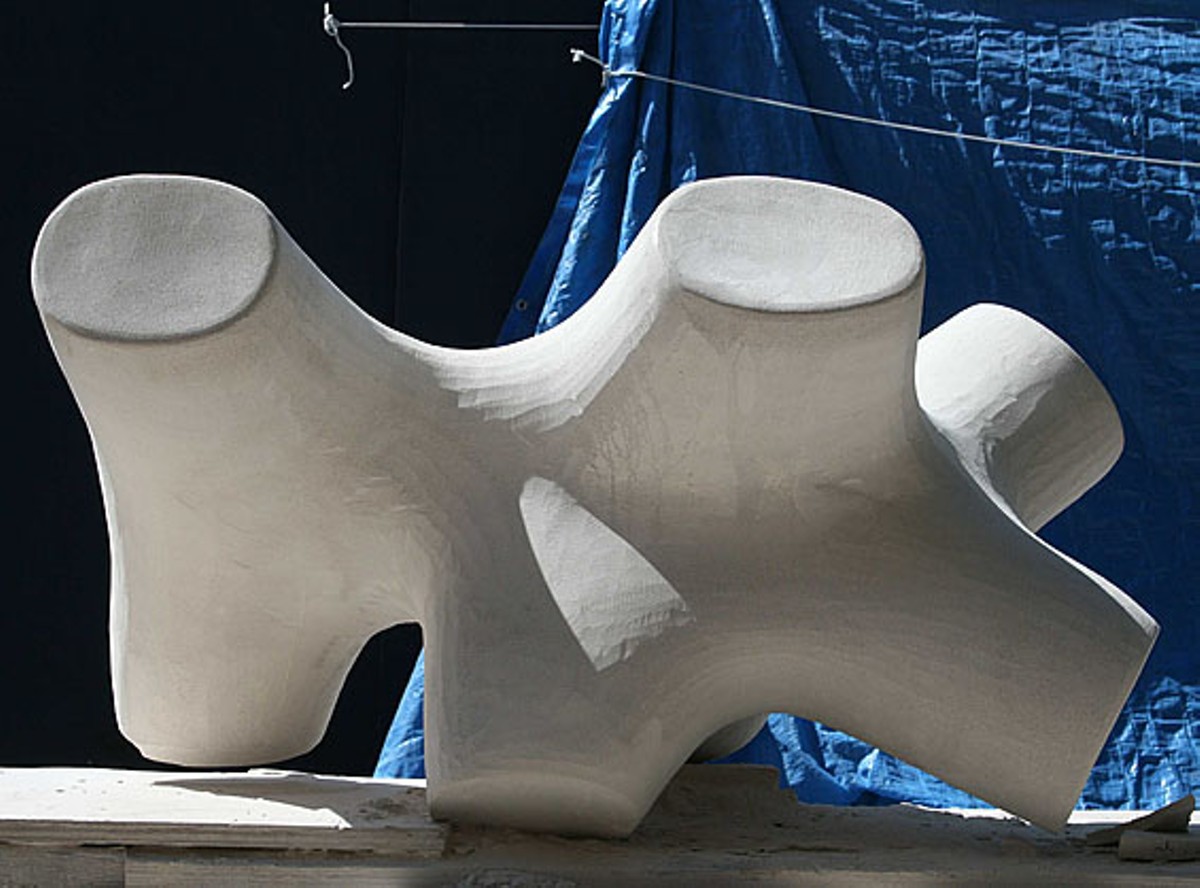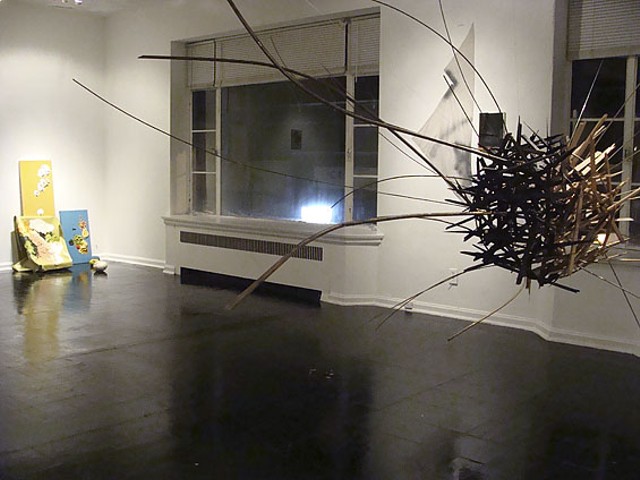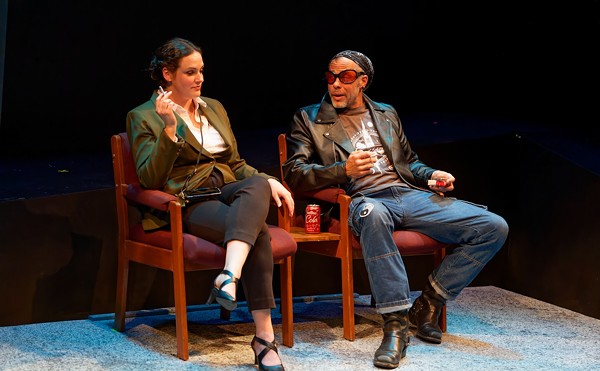Newly Reviewed
Featured Review: Violence Not the interpersonal kind, but the conceptual variety, in which materials, traditions and methods are roughed up and reimagined in ways that express certain antagonistic impulses. Noting a broad cultural current of "violence that is not violence" — perhaps better known as passive aggression — Violence gathers the work of six artists from St. Louis, Kansas City and Chicago who perform all-but-destructive acts through or upon their work. Molly Zuckerman-Hartung affixes torn strips of thrift-store jeans to a small stretched canvas that hangs adjacent to a jagged swath of raw canvas. Justin Gainan scrupulously frames small discarded pieces of dirty paper salvaged from the framing process itself, resulting in what appears to be memorialized detritus. And Brandon Anschultz severs two paintings and conjoins two of their halves in a work that elegantly bears the scars of otherwise brutal deconstruction. Also included are photographs by Natalee Cayton that bear accompanying subscripts describing all they failed to capture, and a video by Michael Sirianni called Blanks, which repeatedly captures the burst of a moment when a television is shut off. Through January 15 at Los Caminos, 2649 Cherokee Street; www.loscaminosart.com. Hours: by appointment.
Maturity and Its Muse The only two traits shared by the artists in this wildly eclectic show of sculpture, painting, drawing, photography and then some is that they're based in St. Louis and on the other side of age 70. And they wear these aspects well. As the first exhibition by the new, locally based nonprofit of the same name (which aims to support positive and productive aging through creativity in the arts), M and Its M has managed to gather a deeply accomplished group of individuals whose biographies and personal accomplishments alone could have provided substance for an exhibition. But the art does not fail to deliver, ranging from quilts made of neckties to drawings of roaring orangutans to beak-shaped ceramic pitchers to colorful pop collages to gold chain-mail chokers. Confident diversity is apparently at the heart of growing old gracefully — a message that addresses art's durability or its importance in keeping us young. Through February 5 at the Sheldon Art Galleries, 3648 Washington Boulevard; 314-533-9900 or www.sheldonconcerthall.org. Hours: noon-8 p.m. Tue., noon-5 p.m. Wed.-Fri., 10 a.m.-2 p.m. Sat.
Ongoing
Ab/Fig Curated by erstwhile Chicago gallerist Wendy Cooper, this group show focuses on work that deliberately straddles abstraction and figuration. With its signature blurring of an otherwise straightforward female nude, a piece by Gerhard Richter feels like the point of origin for this approach. A cursory glance at a print by Ellen Gallagher appears to explore geometric abstraction, while close inspection reveals a pale overall patterning of full, line-drawn lips, her definitive and racially charged motif. Three water colors by painter Barnaby Furnas feature figures shattered by war wounds or excess smoking; the vamping blonde in Girlfriend 1 and Girlfriend 2 has her vanity dismantled by her bad habit, while the stoic soldier in Bits and Pieces is shattered into blood-colored shards. A series of oil paintings by Katherine Bradford depicts swimmers in various states of wavering submergence, their bobbing heads barely discernible beneath thick passes of paint. Whether this show is yet another response to Clement Greenberg's now half-century-old dictates about the supremacy of abstraction (as the title's play on Ab/Ex suggests), it seems certainly to attest to the argument's persistence. Figuration is alive and well, and apparently living in blithe harmony with its non-objective antagonists, producing a new brand of perfectly acceptable if not altogether traditional contemporary art. Through January 15 at William Shearburn Gallery, 4735 McPherson Avenue; 314-367-8020 or www.shearburngallery.com. Hours: 10 a.m.-5 p.m. Tue.-Sat.
Roger Ackling Using rescued pieces of driftwood collected during ocean-side walks, British artist Ackling crafts intimate minimalist sculptures whose presence far exceeds their small scale. Softly weathered but sharp in form, the pyramidal, cubic and rectangular wood pieces are etched with meticulous burnt striations, created by training the sun's rays through a magnifying glass. These lines, which cover the diminutive items' full surface area, move steadily over and between the occasional bent and rusted nail. The work speaks as much in its finished form as it does of its means of arriving there: distilling a habitual communion with nature — from ritual walks to the studied harnessing of the sun — the small sculptures are products of the elements as much as they are of the artist's hand. Jewel-like, the ten pieces appear as relics to moments perhaps otherwise quantified as trivial, when nothing was uttered and no greater action occurred than the lapping of waves and the clearance of a cloud layer. Through January 22 at Schmidt Contemporary Art, 615 North Grand Boulevard; 314-575-2648 or www.schmidtcontemporaryart.com. Hours: noon-5 p.m. Wed.-Fri., 10 a.m.-4 p.m. Sat. and by appointment.
Ahmet Ogut: Underestimated Zones Amsterdam-based Turkish artist Ahmet Ogut stages a number of interventions that blend political activism with Buster Keaton-esque slapstick, highlighting the too-fine distinction between absurdity and moral efficacy. In one series of photographs, the artist has hung a sign, guerrilla-style, in undisclosed but distinctly urban St. Louis locations. The sign reads: "Under 23 Hour Surveillance," the Orwellian aura of ubiquitous intrusion undermined by the potential for a random hour of unsupervised chaos. Elsewhere a dual slide projection transforms two unsuspecting commuter cars into a taxi and a police vehicle, via awkward paper appliqués the artist affixes surreptitiously. In spliced-together videos, Ogut reconfigures a sign that says "Amsterdam" so that it reads "Dreams," "Desert" and "Damned"; human figures slither through the life-size letters in a manner that suggests animals, or pestilence. And in a notable real-time infiltration, Ogut has paved one of Laumeier's galleries in fresh asphalt. The resurfaced space is as succinct in effect as it is multivalent: Appearing like an urban spoof of Walter De Maria's "Earth Rooms," the black granulated material glimmers like spilled precious stones and exudes a distinctly pungent scent that, to the modern senses, is as redolent as seasonal flowers. Also showing — Things We Count, a short dream-like film that pans through a boneyard of defunct WWII aircraft in the Arizona desert: The abandoned fighter planes look harrowingly gorgeous, like a collection of ominous antiques. Through January 9 at Laumeier Sculpture Park, 12580 Rott Road, Sunset Hills; 314-615-5278 or www.laumeier.org. Fall-winter hours: 10 a.m.-5 p.m. Wed.-Fri., noon-5 p.m. Sat.-Sun. (Outdoor grounds open daily from 8 a.m. to a half-hour past sunset.)
Infrastructure Reversing the everyday use of rebar, local sculptor Arny Nadler exposes the ribbed steel to exploit its formal potential. Strands of the metal are joined side by side and shaped into undulating, wave-like forms, producing work that is at once delicate, porous and weightily proletarian. Accompanying the rebar studies are upright, totemic sculptures made of concrete, beneath the surface of which rebar writhes and occasionally protrudes with stitch-like ridges. These works appear like cloaked figures, the surface texture of the concrete revealing all the imprints of plastic coverings and other molding devices, producing the vague appearance of wrinkled and lacerated skin. While these roughly elegant works proclaim a determined formalist agenda, they — like Nadler's other evocative sculpture series, Beacons — suggest strong narrative associations, from the bound body and oceanic waves to the decline of industry and disappearance of cottage-craft expertise. Through January 8 at Good Citizen Gallery, 2247 Gravois Avenue; 314-348-4587 or www.goodcitizenstl.com. Hours: noon-5 p.m. Fri.-Sat. and by appointment.
Overpaper This selection of works on paper features both local and national artists, including Carmon Colangelo, Jill Downen, Ann Hamilton, Judy Pfaff and Buzz Spector. Hamilton's Carriage is a handcrafted version of the pleated seventeenth-century collar known as a ruff; in this version the frills are the product of fanned-out paperback pages, which have been diced into thin strands and rebound at the neckline. Knowledge, it's suggested, is an awkward freight, or a conspicuously outdated adornment. Jill Downen has translated her white-on-white plaster installations into elegant two-dimensional forms, where bright white paper subtly ripples with an undulating (and fleshlike) surface texture of white gypsum. Judy Pfaff's piece is "paper art" at its most opulent extreme: In a large wall-mounted shadow-box, silk flowers, paper boats, scraps of newspaper and other seeming detritus cluster to assemble a kind of faux terrarium, where the most unnatural elements play the role of nature at its most wild. Also showing — Leslie Laskey's Portraits: Artists and Friends, which reimagines the gallery's entry space as a lamp-lit reading room, in which drawn and painted portraits of the artist's favored forebears hang in gilt frames or lean in piled decorative arrangements. The effect is unapologetically nostalgic and, as such, charming — endorsing full throttle the romantic myth of the golden age of avant-garde "genius," from Picasso to Giacometti to Stein. Through January 15 at the Bruno David Gallery, 3721 Washington Boulevard; 314-531-3030 or www.brunodavidgallery.com. Hours: 10 a.m.-5 p.m. Wed.-Sat., noon-5 p.m. on the first Sun. of every month and by appointment.
Pae White: Dying Oak In this cosmos-like trip through the inner strata of an 800-year-old oak tree, Los Angeles-based Pae White creates a digital approximation of her dangling, delicately handmade mobiles and tapestries. White's work, which has previously focused on the details of traditional craft and the minutiae of nature, here takes on the medium of video with the same obsessive, patient eye. Each pixel in this animation appears, like White's mobiles, to dangle from invisible strands; the viewer is drawn in and through the impossible space of the tree's interior as though it were simultaneously solid and penetrable. Striking a mesmerizing balance between the urge to deeply and pragmatically study a subject and simply absorb the intangible qualities of its aesthetic presence, Dying Oak draws something tactile out of the virtual ether. Also showing — Portraits of Depression-era America This collection of photographs, predominantly drawn from Farm Security Administration commissions, is a frank testament to the art of directness, in which candid documents convey formalist sophistication and profound humanism — and exemplify one of the finest uses of federal funding. Through January 9 (Depression) and January 16 (Oak) at the Saint Louis Art Museum, 1 Fine Arts Drive (in Forest Park); 314-721-0072 or www.slam.org. Hours: 10 a.m.-5 p.m. Tue.-Sun. (10 a.m.-9 p.m. Fri.).
Remembering Teddy An intimate reflection on an important friendship, this collection of photographs, needlepoint, cards and assorted other artifacts fondly exchanged and saved between two people is not merely a homage to Carla "Teddy" Trova, who died in 2008, but to the creative dimension of gift-giving. Assembled by local gallerist Jim Schmidt, the work included pays tribute to the wife of the late artist Ernest Trova, whom Schmidt befriended in the late 1960s, when he was employed as the sculptor's assistant. Teddy (as she was known) taught Schmidt the art of needlepoint, along with, it seems, the other arts of living — cooking, greeting-card making and unconditional encouragement. What emerges is a portrait of two previously unsung talents: Teddy, it is clear, was a gifted collagist, deploying film stock from her casual practice as a photographer as a core material; and Schmidt reveals himself to be an inspired needlepoint maker whose work is both abstract and illustrative (enlarging panels of Buster Brown comics, which he collected). One of the most moving elements of the exhibit is a room dedicated to Schmidt's black-and-white photographs, which he developed, affixed to matte board and assembled in a box as a gift for Teddy. The imagery is largely composed of portraits of his former high school students (Schmidt, a native East St. Louisan, was an English teacher there for five years) and is accompanied by lyrics by Bob Dylan, Jim Croce and other '60s-era singer-songwriters. The radiance of these portraits is almost shocking — the young people shine with a modest joy for life that can only be captured unself-consciously, by a friend or peer. Their fundamental artlessness encapsulates the tenor of this unique and moving exhibition of all that is impossible to commodify. Through January 8 at PSTL Gallery, 3842 Washington Boulevard; 314-531-4304 or www.paceframing.com. Hours: 10:30 a.m.-5 p.m. Tue.-Sat.
Mario Trejo Presenting the trials and errors of a self-imposed quest to execute "at least one million hand-drawn and counted idiosyncratic circles" with pen on enameled panel, local artist Trejo distills this supreme act of enervation into a series of paintings recalling the placid semblance of the night sky. The rendering of the circles varies from piece to piece, per the "idiosyncratic" dictate: Some works appear like a glossy expanse of solid black, while others depict the drawn equivalent of a tangle of gray and black rubber bands. As the artist's statement admits, this is not work with Zen-like ambitions; rather, a calculator was in one hand, noting marks, while the other was at work drawing circles. What seems to be the more likely "moral" of this elected Sisyphean task has something to do with art's love of novelty and heroic expertise: How does one acquire the miracle of creative genius? Given a question that large, an attempt to approximate the cosmos seems as good a place to start as any. Through January 7 at Metropolitan Gallery, 2936 Locust Street; 314-535-6500 or www.thenu-artseries.org. Hours: 11 a.m.-5p.m. Wed.-Fri., Saturday by appointment.






